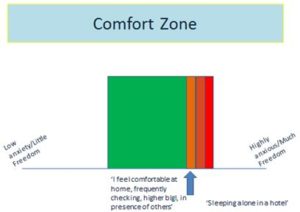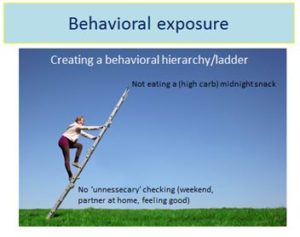The traffic light metaphor is a well-known and widely used metaphor/exercise in psychology.
The red, orange and green colours of the traffic light symbolize phases in our well-being.
- In green, we feel relaxed, happy, physically well. We are ok. In this green phase we feel comfortable both emotionally and physically. With regard to our blood sugar, in the green zone they are ok. No hypo’s, no hypers, no discomfort of increasing or decreasing blood sugar. We feel comfortable in every way.
- In red, we feel totally miserable. We have crossed a line and must pay the price… Emotionally we may feel exhausted, panicked, sad, depressed, stressed or experience another very negative emotion. Physically, many unpleasant and varying symptoms can be present: headaches, nausea, dizziness, pain, shortness of breath, but also high or low blood sugar.
Often, people will say that ‘’all of a sudden’’ they went from feeling ‘’green’’ to ‘’red’’. One minute they were fine, and the next they felt horrible. Be it emotionally, be it physically, or with regard to blood sugars: this sudden change is not as sudden as we think.
- In most cases, we have been warned by our body and brain about the approaching red phase. As if our body and brain are telling us: ‘’Alarm! Be aware! Something unpleasant is coming up!’’ This alarm phase is the ‘’orange’’ phase. In this orange phase we start feeling uncomfortable. In many ways our body and brain are trying to tell us that ‘’we have crossed a line’’. Our body and brain are trying to tell us that we need a short break, something to eat or drink, a relaxing moment, medication, some positive distraction, the attention of a loving person… And although we ‘’know’’ that this is what we need, we don’t really act upon these needs. Many times we are just too busy or inattentive to pick up upon those signals… It is not that we really cannot feel them, but in our busy daily lives, we have unlearned ourselves to pay attention to them. When ‘’ignoring’’ these signals, the uncomfortable feeling will get stronger and more negative, and eventually will lead to the ‘’red’’ phase.
For many reasons, it is good to improve your skills to recognize the signals in the ‘’orange’’ phase, and to act upon them. This is how you can try to prevent or decrease the ‘’red phase’’, be it about high/low blood sugar or panic attacks.
But before you can do something with these signals, you will have to become increasingly aware of the signals first.
When you want to train yourself in recognizing ‘’your orange signals’’, there are some things you can do:
- Whenever you experienced a ‘’red phase’’ (panic, intense sadness, hypo’s, hyper’s etc.), take some time to think about the moments BEFORE the red phase. How were you feeling a couple of hours before? Do you think you have ignored any signals (hunger, irritation, tired, feeling warm/cold, feeling emotional etc.), maybe because you were busy or thinking that ‘’it could wait’’? If you have felt (a little bit) uncomfortable in the hours before you entered the ‘’red phase’’: hooray! Then you have probably started to recognize the first ‘’orange signals’’
- Start increasing your awareness on the ‘’orange signals’’ by asking yourself how you feel, at various timepoints during the day. It takes only 30 seconds, and you can easily do it at all moment when you are ‘’waiting’’ (for the coffeemachine, printer, for the traffic light, in the elevator, during public transport etc.). Use these seconds/minutes to train your awareness, by asking yourself whether you think you have ignored/are ignoring any signals (hunger, sleep, irritation, feeling warm/cold, feeling emotional etc.)
- If your awareness on the ‘’orange signals’’ has increased, you can start to act upon them. Of course, this does not mean that you will need to go to bed, when you feel sleepy during the day at work… Or that you can just take a lunch break whenever you need.. But sometimes a ‘’microbreak’’ is already a first good step, towards less ignoring of and acting upon important signals. Examples of microbreaks are: just getting something to drink, opening a window, doing a one-minute breathing exercise, doing some stretching etc.
Hopefully, these tips will help you in your first attempts to recognize and influence your traffic light!

